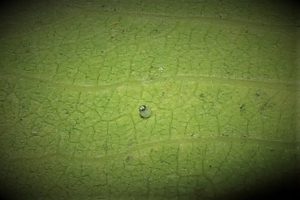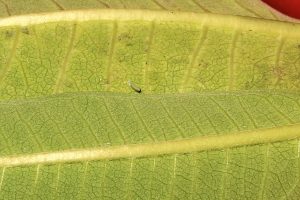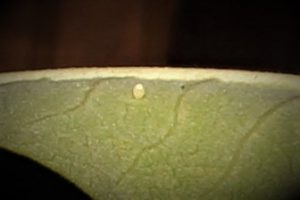Last Thursday (July 9th) I came across this tiny monarch butterfly egg. The eggs normally hatch within 3-5days. The egg always has ridges and a white spot on the top of it as pictured. Before the egg is ready to hatch, the top of the egg becomes dark. That is the head cap. Once you see that, the caterpillar will hatch very soon. Usually within hours.

The top of a monarch egg will have a dark spot before it’s ready to hatch photo/Tina Evangelista-Eppenstein
And that’s what happened. Within three hours, I found a new monarch caterpillar eating its shell which contains lots of nutrients. Caterpillars are the larval stage of the butterfly and moth (lepidoptera) families. After the cat is done eating its shell, it will proceed to eat the leaf on which the egg was laid by its mama monarch butterfly.
The length of time they remain in the larva stage varies from species to species. The monarch will grow 2000% from the egg stage to the 5th instar caterpillar. This usually takes about two weeks when their sole purpose is to eat to get fat as possible.
.
The entire lives of monarch caterpillars are consumed by eating milkweed leaves. They transition to each instar in which they shed their skin and become larger also entails to changes to the caterpillar body.
The 5th and final instar is when they eat non-stop to fatten up in preparation to make their chrysalis. When you see a fat caterpillar hanging upside down, it’s time for that cat to shed his skin one last time. They will never eat or need to eat with their mouth again. They lose their mouth parts during their metamorphosis. They will have a proboscis in which to drink nectar.
Meanwhile, watching this minute caterpillar I found who has just started its journey to becoming an impressive monarch butterfly is intriguing no matter how many times I’ve seen it. A tiny caterpillar turning into a butterfly has to be one of the great wonders of this world. An insect who can’t see, eats with its mouth walks who transforms itself into a flying, seeing, drinking insect is riveting to see for yourself.
So few eggs and caterpillars survive in the wild. They get eaten by predators mainly but they also become the victims of parasitic insects who inject them with their own eggs. Those eggs grow inside of the caterpillars until they’re ready to enter the world. Many times this disgusting act occurs when a chrysalis is being made. The unsuspecting caterpillar tries in vain to make his chrysalis as the eggs or maggots exit the body or the chrysalis. I’ve watched caterpillars struggling to stay in position to create a chrysalis as the predators are coming out of them. By this point, the caterpillar shrinks in size because his insides have been eaten by the parasites. Not a pleasant scene to witness. I will freeze the caterpillar and/or chrysalis when it starts to happen.
This is why I raise monarchs. Because the population of monarchs has diminished by the environment, losing their habitat, predators and the use of pesticides, I’m trying to do my part to increase their numbers. There is controversy surrounding people who raise monarchs but I found the study the so-called experts performed flawed.
The number of people who are raising them continues to increase. This would be a great educational and fun activity to do with your children over the summer months. Just make sure you have enough milkweed plants for the caterpillars.
Here’s hoping 2020 is a great year for the monarch butterflies!
Tina Evangelista-Eppenstein is a television talk show host, speaker, writer, and an unabashed animal advocate. Her love for animals and quest for the hard truth is what drives her passion for all things animals. She hosts the television show, “A Close Up Look at Animal Welfare Issues.” She adores her tripawd, Brody, who was a formerly abused pup who lost his leg because of cruelty inflicted upon him. If you’d like Tina to talk to your group or have a story, please email her at tevangelistaepp@yahoo.com. Like https:www.facebook.com/ACloseUpLookatAnimalWelfareIssues and be sure to check out AnimalWelfareIssues.com.



Wow parasites r disgusting to lay their eggs inside the caterpillars. I never heard of that.
How long will it take the caterpillar to turn into a butterfly ?
Bo, it is disgusting when predators such as wasps lay their eggs inside monarch caterpillars. While milkweed is a host plant for a monarch butterfly, wasps and other predators find living insects to be their hosts where they lay their eggs. Sounds really sick.
It takes about a month from when an egg is laid until a butterfly emerges from its chrysalis. Great question.
Thx!
That’s cool to see. I’ve never seen a monarch egg. that’s really cool that you do that. Will you be raising monarchs this year? Keep up your good work, Tina.